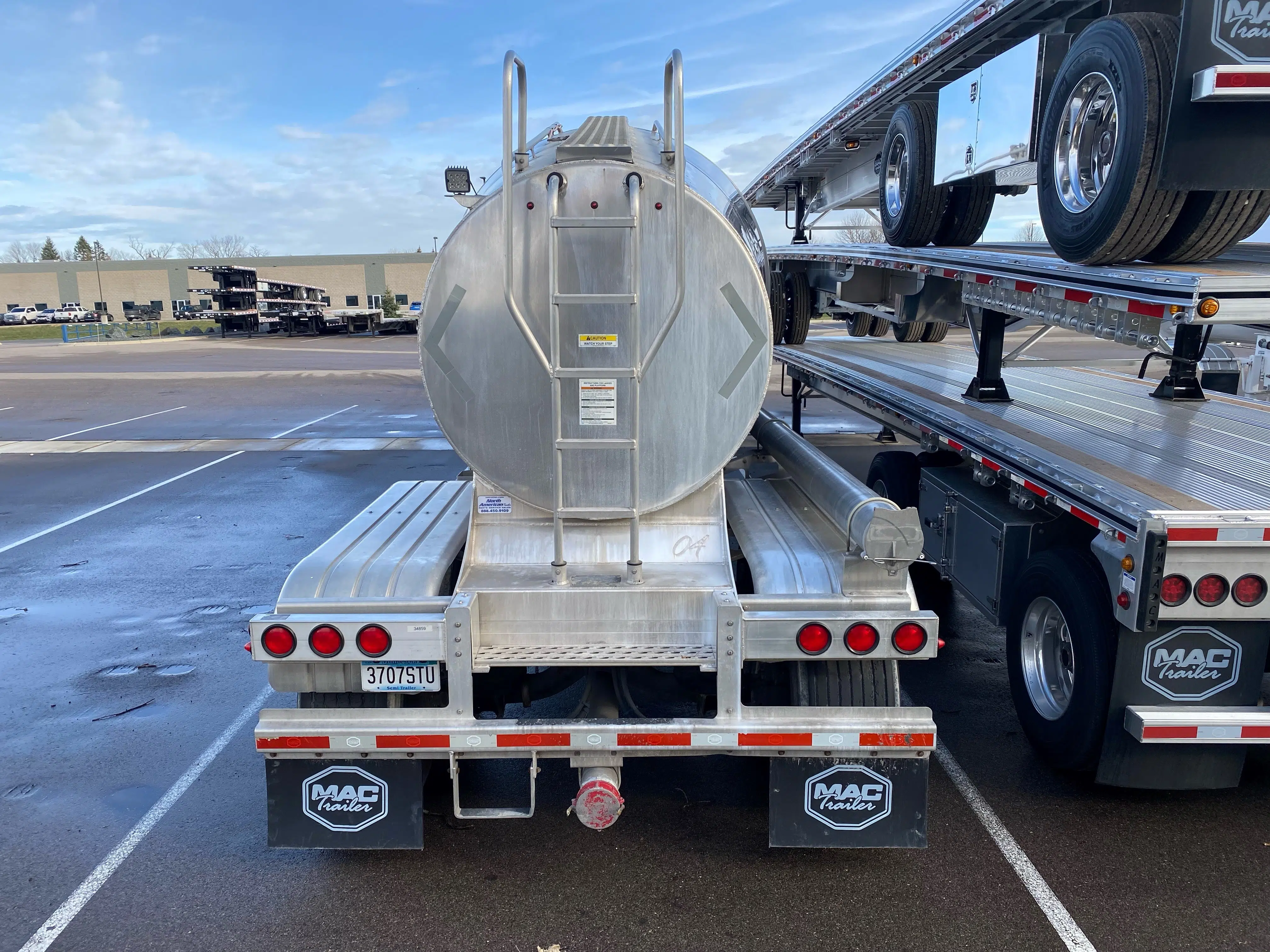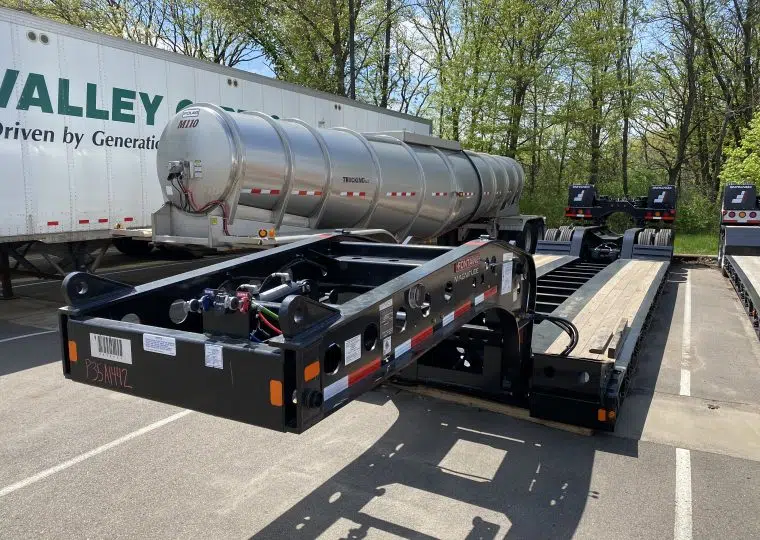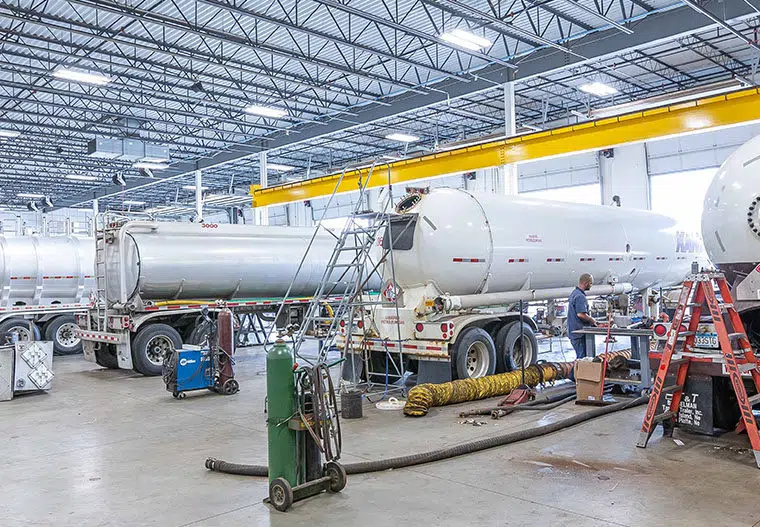These days, it’s pretty much impossible to go anywhere without encountering some type of tanker trailer – and that’s a very good thing! Tanker trailers, which are easily identified by their shiny, cylinder-shaped enclosed tanks, deliver everything from food to water to gas, ensuring we have the items we need to go about our daily lives. Therefore, it’s not an exaggeration to say that these vehicles play an extremely important role in keeping our economy rolling – pun intended.
So what exactly are tanker trailers and where do they fit into the trucking industry? We’re glad you asked! In this blog, we’ll go over all the tanker trailer basics and outline the different types of tanker trailers, what industries they’re most popular in, the types of products they haul, and their benefits. Buckle up – it’s going to be an informative ride.
 Tanker Trailer Basics
Tanker Trailer Basics
Whether they’re constructed of carbon steel, stainless steel, fiberglass reinforced plastic, or aluminum, tanker trailers come in three basic designs – baffles, bulkheads, and smoothbores. These designs aren’t motivated by aesthetics, though. They’re aimed at impacting the way liquid cargo moves while the vehicle is in operation and, ideally, reducing the chances of spills and accidents. When you consider that many of the liquids being transported are hazardous to humans, animals, and the environment, it’s especially important to make sure to choose the right type of tanker trailer to fit your specific needs.
Baffles:
These tankers contain angled dividers with holes designed to slow the back-to-front motion of liquid cargo and keep it distributed evenly. This makes for a more smooth and stable ride.y
Bulkheads:
Bulkhead tankers feature solid dividers that create mini-storage compartments inside the tanker that can be used to carry a variety of liquids at once. Like baffles, the design of the bulkhead helps minimize the back-and-front motion of the liquid being transported.
Smoothbores:
Smoothbore tankers, which are sometimes referred to as unbaffled tankers, have one smooth, long interior compartment which makes them easier to clean and sanitize. However, without the barriers found in baffles and bulkheads, it also allows the liquid cargo to move around freely which can sometimes adversely affect the vehicle’s operation.
Sizes
Just like cars and trucks, tanker trailers vary greatly in terms of size. Their capacity is measured by their gross vehicle weight rating, which is the weight of the vehicle – in pounds – after it’s been loaded up with cargo. The largest tankers have a GVWR greater than 33,001 pounds and are subject to a high level of federal regulations – but more on those in a moment.
Small tanker trailers have a maximum capacity ranging from 1,000 to 3,000 gallons and are often used to transport cargo within local communities. You may see tanker trailers of this size bringing fuel to planes at the airport or delivering domestic fuels like liquified petroleum gas to homes and businesses. Larger tanker trailers, on the other hand, can hold up to 11,600 gallons and are generally built to go much longer distances and deliver their cargo in bulk.
However, when you’re talking about tanker trailer capacity, it’s important to remember that 100 gallons of milk have a different weight and density than, say, 100 gallons of gasoline. Therefore, adjustments must be made when determining how much liquid cargo a vehicle can carry safely.
Licenses and Compliance Regulations
Because of their size and the type of cargo, they transport, tanker trailers – and the people who drive them – are heavily monitored and regulated by the Federal Motor Carrier Safety Administration.
In the section above, we mentioned the GVWR because it’s a critical guideline set forth by the FMCSA and we emphasized that it’s measured in pounds. We also mentioned the maximum capacity (in gallons) that tanker trailers can carry safely. And we didn’t even get to tell you that dry bulk material is measured in cubic feet. Yep, that’s a lot of math!
With so many different types of measurements involved, it’s crucial that fleet managers pay close attention when calculating the weight of their cargo to stay in compliance with the law and avoid costly fines.
As far as driver regulations go, anyone operating a tanker that contains more than 1,000 gallons of liquid must pass a test to get an endorsement placed on his or her commercial driver’s license (CDL). This is just another way to ensure the safety of everyone on the road.
Different Types of Tanker Trailers
Tanker trailers play an essential role in delivering supplies for just about every industry you can think of – and maybe a few that don’t immediately come to mind. While all of these vehicles fall under the strict regulations we discussed in the previous section, the specific types of regulations can vary based on the materials being transported. For example, chemicals and fuels are subject to the Hazardous Materials Transportation Act while the regulation of food and beverage items falls under the purview of the U.S. Food & Drug Administration.
Fuel
As the name suggests, fuel tankers are widely used in the oil and gas industries and are designed to deliver petroleum-derived products including jet fuel, ethanol, diesel, and gasoline safely across the U.S.
Food
The food and beverage industries rely on food tankers to transport milk, fruit juices, vinegar, alcohol, vegetable oils, and corn syrup, among other liquids. Most food tankers are insulated and have temperature control options to protect the integrity of the products they’re carrying, a huge benefit in making sure these items are kept safe for human consumption.
Water
Water tanker trailers are employed by a variety of industries including agriculture, construction, the government, and the military. The water they deliver can be used for irrigation, dust suppression, and firefighting and also to fill hot tubs and pools, among other things. Water tanker trailers come in many sizes, making them especially versatile and incredibly useful to have in your fleet.
Chemicals
The industrial industry employs the use of chemical tankers to haul manufacturing materials such as chlorine, hydrogen fluoride, and ammonia. Chemical tankers are often made of stainless steel and typically measure between 42 and 45 feet long.
Dry Bulk
Also known as pneumatic tankers, dry bulk tankers are used in a number of industries including food, construction, and industrial manufacturing. They transport everything from dry food products like starch and flour to chemical powders, sand, cement, and plastic pellets. Dry bulk tankers can be unloaded using compressed air, which represents significant savings in terms of both time and money
Other
Other tanker trailers include asphalt tankers which are designed to transport contents that need to remain hot and agricultural trailers which haul pesticides and fertilizers to agricultural sites.
For all of your tank related needs, visit our reliable team at North American Trailer
At North American Trailer, we recognize that buying a new or used tanker trailer is a huge investment and our team is here to provide you with the guidance you need to feel confident about your purchase. We carry high-quality tanker trailers at reasonable prices and we’re committed to helping you find the right vehicle to fit your needs, and keeping it on the road with our tank repair services.
If you’re looking for excellent customer service from people you can trust, look no further than North American Trailer. Contact us today – we can’t wait to exceed your expectations.



